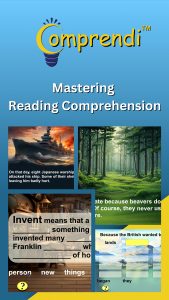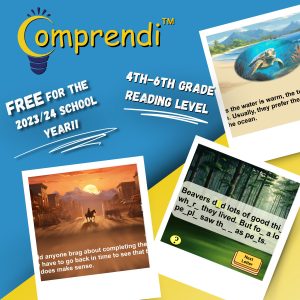It’s been known for millennia that children love stories. As human beings, our brains are wired to receive information in this form. Stories help the reader form the emotional connection that strengthens the neural pathways needed to retain information. That’s why it’s easy for us to recall the words of our favorite songs, poems, and films. If you have any doubts about this, just think of how the world was affected by the wizardry of Harry Potter.
The Comprehension Problem
Schools capitalize on this by presenting students in kindergarten through third grade with lots of information in story, or narrative, form. Around fourth grade, however, schools abruptly limit the presentation of narrative texts. Instead, they switch primarily to “expository,” or informational text. That’s the material we’re used to seeing in academic textbooks in all subject areas, such as social studies, biographies, and history. This forces the children to confront dry expository texts that have the twin handicaps of being boring and difficult to digest. While the words are still in English, nothing else about the expository text is familiar to the children.
The end result is the pervasive reading failure that has marked our nation for decades. According to the National Assessment of Educational Progress in 2022, the percentage of fourth-graders performing below NAEP Basic ranges from 30 to 79 percent. In other words, 30-79% of our fourth graders have, at best, only the most rudimentary reading skills.
Further, the situation is getting worse. Possibly exacerbated by COVID-19, there has been a decline in the past few years. For example, in grade 4, 29 states scored lower on informational reading in 2022 than they did in 2019.
A Comprehension Solution
For the health of our children and our nation, we must overcome the pandemic of reading failure. With this goal in mind, using my training as a designer of educational programs, I have created a new form of text — NarrEx™. It combines narratives’ motivational appeal with expository texts’ informational context.
For example, the program has a story entitled An Inventor Who Happened to be a Boy to teach the scientific principle of irrigation. It recounts the true events experienced by a boy in Africa who created an irrigation system for his village. He did it by building something unknown to the people—a windmill bringing water to the fields. Unlike pure narrative text, the focus is not on the emotional forces in his life. Instead, it is the scientific information he sought and used to solve the problem. The presence of a real boy allows the reader to identify with the concepts in a way that is not available in typical expository material. NarrEx™ texts are a bridge that allows readers to successfully transition into the world of expository text they’ll be encountering throughout their years in school.
he sought and used to solve the problem. The presence of a real boy allows the reader to identify with the concepts in a way that is not available in typical expository material. NarrEx™ texts are a bridge that allows readers to successfully transition into the world of expository text they’ll be encountering throughout their years in school.
The power of NarrEx™ is reinforced by a second key feature that is termed NarraVis™. It involves using the astounding capabilities of the computer to provide—in visual form– the key background knowledge that research has shown is vital for reading comprehension. The illustrations are designed to help children visualize the historical, scientific, and other key information conveyed in the story. This appealing information brings the ideas to life, while simultaneously evoking the emotional responses that help the reader maintain attention. In addition, it is faster and far more effective than presenting ideas primarily via written language. When well-designed and plentiful visuals are combined with NarrEx™ text, the result is synergistic. Children comprehend the information more quickly and retain it more thoroughly.
NarrEx™ and NarraVis™ have been incorporated into Comprendi™, my new reading program. If you’d like to learn more about Comprendi™ and the educational techniques discussed above, please visit our website.
More About the Author:
 Dr. Marion’s Learning Lab is the creator of Comprendi™, the new computer-based reading comprehension program for 4th grade and beyond that combines the new NarrEx™ form of writing, compelling true stories, and carefully designed illustrations to give children mastery of all key components of comprehension. Based on over six decades of research, Dr. Marion’s innovative NarrEx™ text blends the motivational pull of narratives with the essential but challenging information-laden content of expository texts. Dr. Marion’s approach to illustration, called NarraVis™, helps students gain essential background knowledge and other key information conveyed in the story via an extensive use of informative graphics. Together, NarrEx™ and NarraVis™ produce rapid and significant improvement in reading comprehension – while the kids actually enjoy using the program! Learn more by visiting today!
Dr. Marion’s Learning Lab is the creator of Comprendi™, the new computer-based reading comprehension program for 4th grade and beyond that combines the new NarrEx™ form of writing, compelling true stories, and carefully designed illustrations to give children mastery of all key components of comprehension. Based on over six decades of research, Dr. Marion’s innovative NarrEx™ text blends the motivational pull of narratives with the essential but challenging information-laden content of expository texts. Dr. Marion’s approach to illustration, called NarraVis™, helps students gain essential background knowledge and other key information conveyed in the story via an extensive use of informative graphics. Together, NarrEx™ and NarraVis™ produce rapid and significant improvement in reading comprehension – while the kids actually enjoy using the program! Learn more by visiting today!
Latest Posts

Can you believe May is here and summer is just around the corner?! Whether you're winding down your homeschool year or preparing to continue forging ahead with your learning, hopefully, these…
Read more >
It’s been known for millennia that children love stories. As human beings, our brains are wired to receive information in this form. Stories help the reader form the emotional connection…
Read more >
While nearly every college and university today is eager to accept homeschooled students into their institutions, homeschooling families need to understand that their student’s application…
Read more >

